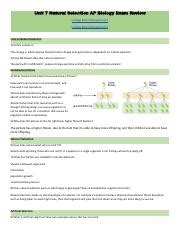A Comprehensive Exploration into the Control and Transfer of Genetic Information

Unit 7 of the Advanced Placement Biology curriculum embarks on a captivating exploration into the intricate mechanisms that govern gene regulation and evolution. Understanding these fundamental processes is essential for deciphering the complexities of life and unraveling the mysteries of biological diversity.
Chapter 1: Gene Regulation: Controlling the Expression of Life
Gene regulation lies at the heart of orchestrating cellular processes. It dictates which genes are expressed, when they are expressed, and to what extent. This chapter delves into the key mechanisms involved in gene regulation:
- Transcriptional Regulation: Initiation, elongation, and termination of gene transcription, influenced by factors such as promoters, enhancers, and silencers.
- Translational Regulation: Control of mRNA translation into proteins, affected by factors like ribosome binding sites, microRNAs, and translation factors.
Chapter 2: Evolution: The Driving Force of Genetic Diversity
Evolution is the cornerstone of biological diversity, shaping the remarkable array of life forms we witness today. This chapter investigates the fundamental principles that drive evolutionary change:
- Natural Selection: The process by which traits that enhance survival and reproduction become more prevalent within a population.
- Genetic Drift: Random changes in allele frequencies within a population, particularly in small populations.
- Gene Flow: The exchange of alleles between populations, which can influence genetic diversity and adaptation.
Key Concepts in Unit 7
Gene Regulation
- Promoters: DNA sequences that initiate transcription.
- Enhancers: DNA sequences that enhance transcription.
- Silencers: DNA sequences that suppress transcription.
- MicroRNAs: RNAs that inhibit translation of specific mRNAs.
- Ribosome Binding Sites: Regions of mRNA where ribosomes bind to initiate translation.
Evolution
- Natural Selection: Differential survival and reproduction based on traits.
- Fitness: The ability of an individual to survive and reproduce in a given environment.
- Hardy-Weinberg Equilibrium: A theoretical state of genetic equilibrium in a population.
- Genetic Drift: Random changes in allele frequencies within a population.
- Gene Flow: The exchange of alleles between populations.
Real-World Applications of Unit 7 Concepts
Understanding gene regulation and evolution has far-reaching implications for various fields:
- Medicine: Identifying genetic mutations associated with diseases, developing targeted therapies.
- Agriculture: Engineering crops with enhanced traits, such as disease resistance or drought tolerance.
- Forensics: Utilizing DNA profiling for identification and criminal investigation.
- Conservation Biology: Monitoring genetic diversity in endangered species, developing conservation strategies.
Benefits of Studying Unit 7 AP Bio
- Enhanced Understanding of Life Processes: Comprehending how gene regulation and evolution shape the diversity and complexity of life.
- Critical Thinking Development: Analyzing complex scientific concepts and drawing evidence-based conclusions.
- College Preparation: Building a strong foundation for further studies in biology and related fields.
- Practical Applications: Gaining insights into real-world applications of genetic research and its impact on society.
Pain Points and Motivations
- Complexity of Concepts: Unit 7 AP Bio involves abstract and challenging topics that require diligent study.
- Abundant Material: The vast amount of information can be overwhelming, requiring effective time management and prioritization.
Tips and Tricks for Success
- Engage Actively: Attend class regularly, participate in discussions, and ask questions.
- Utilize Study Resources: Take advantage of textbooks, online materials, and study groups.
- Practice Problem-Solving: Solve practice problems regularly to build confidence and enhance understanding.
- Review Regularly: Revisit concepts and review material consistently to reinforce your knowledge.
Conclusion
Unit 7 AP Bio unveils the intricate mechanisms of gene regulation and evolution, providing a profound comprehension of the fundamental processes that govern life and drive biological diversity. By exploring these concepts, students gain invaluable knowledge that extends beyond the classroom, enabling them to make informed decisions and contribute to the advancement of scientific research.
Table 1: Promoters and Enhancers
| Feature | Promoter | Enhancer |
|---|---|---|
| Location | Upstream of start codon | Can be located upstream, downstream, or within the gene |
| Function | Initiates transcription | Enhances transcription |
| Regulation | Influenced by specific transcription factors | Can be regulated by various transcription factors and co-activators |
Table 2: Natural Selection Mechanisms
| Mechanism | Description |
|---|---|
| Stabilizing Selection | Favors intermediate phenotypes |
| Directional Selection | Favors one extreme phenotype over the other |
| Disruptive Selection | Favors both extreme phenotypes over the intermediate |
Table 3: Hardy-Weinberg Equilibrium
| Condition | Equation |
|---|---|
| No mutation | p² + 2pq + q² = 1 |
| No migration | p² + q² = 1 |
| No non-random mating | p + q = 1 |
Table 4: Gene Flow
| Effect of Gene Flow | Description |
|---|---|
| Increase in genetic diversity | Introduction of new alleles into a population |
| Decrease in genetic diversity | Removal of alleles from a population |
| Genetic drift | Random changes in allele frequencies due to small population size |
